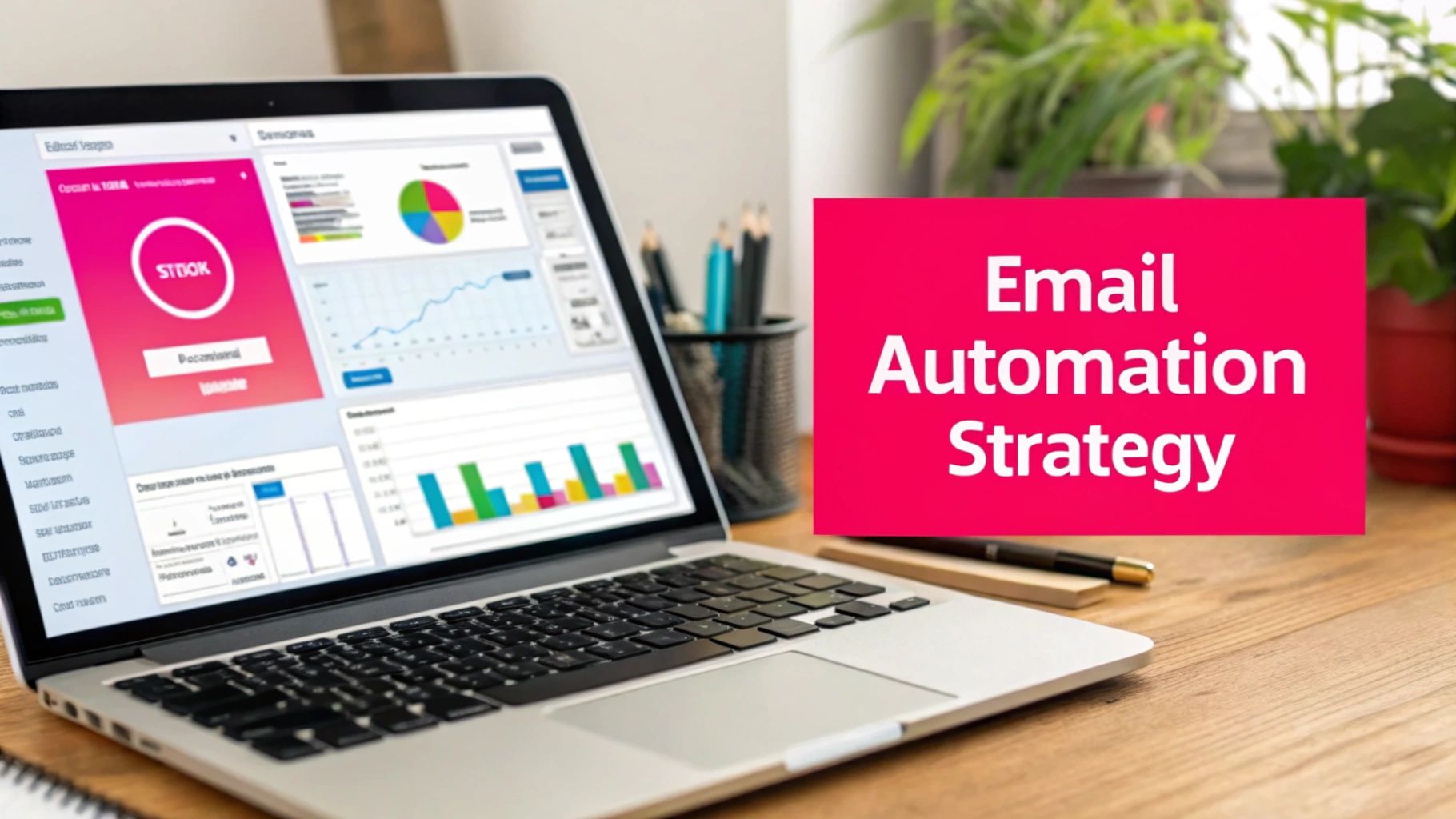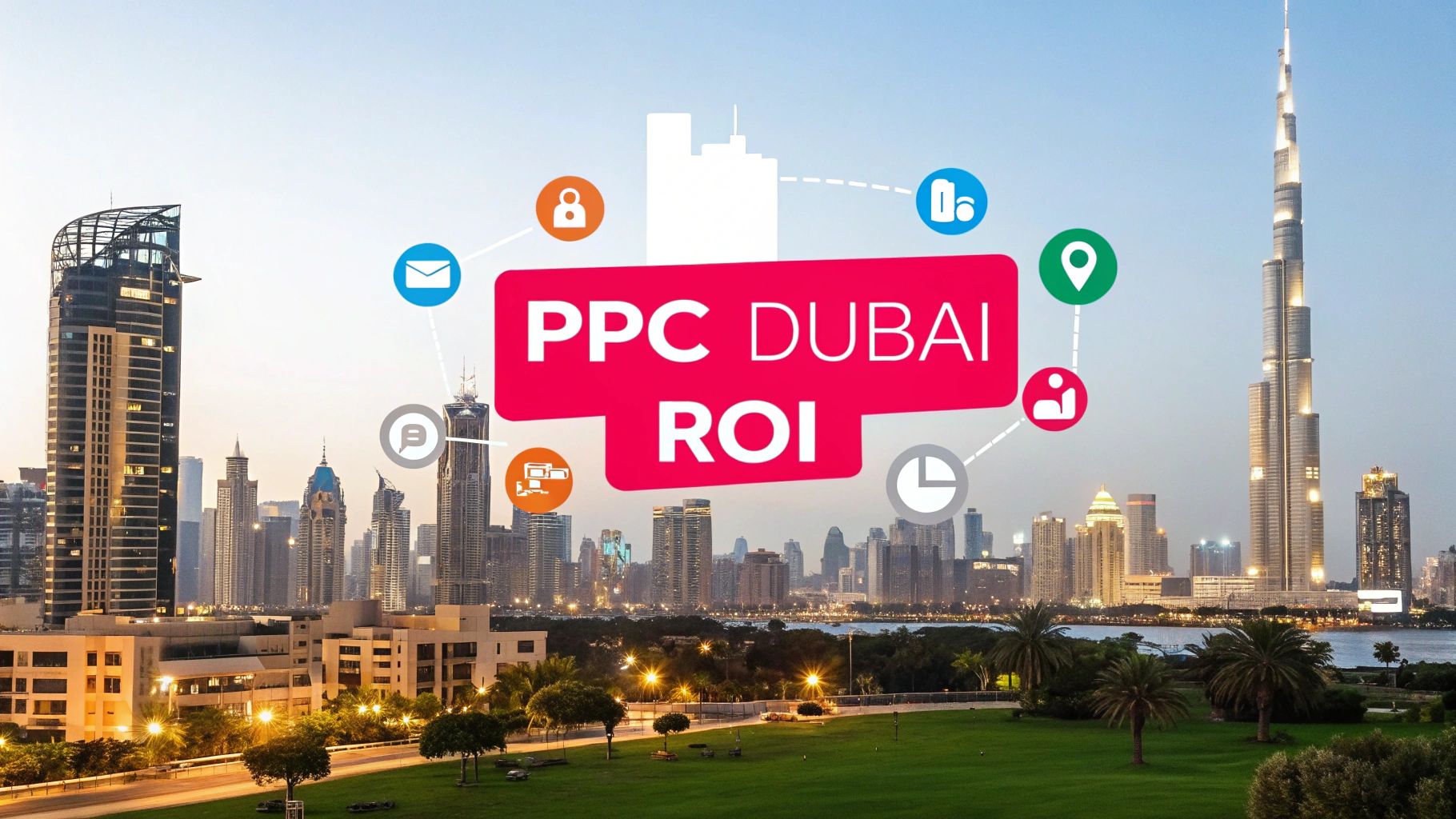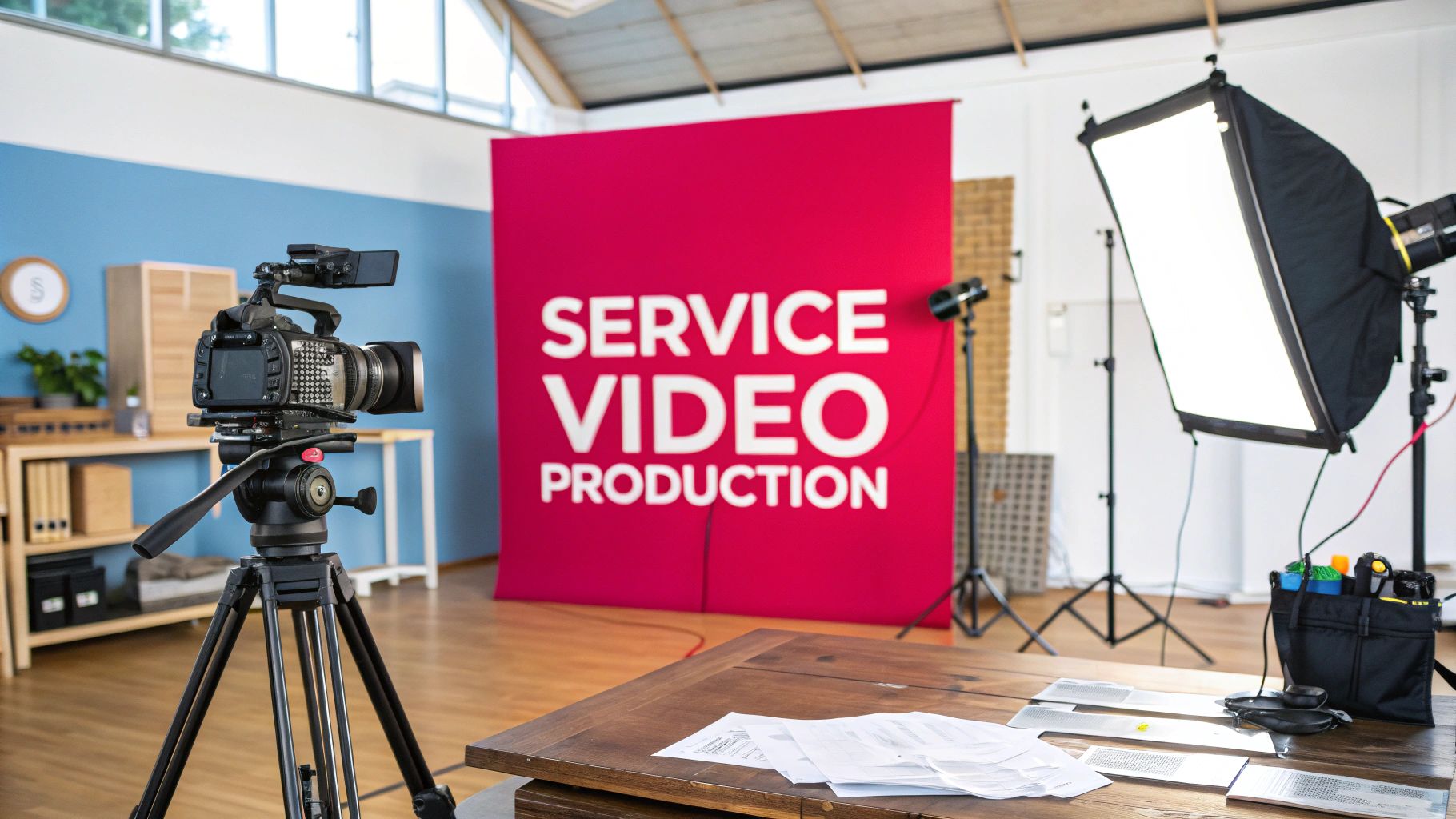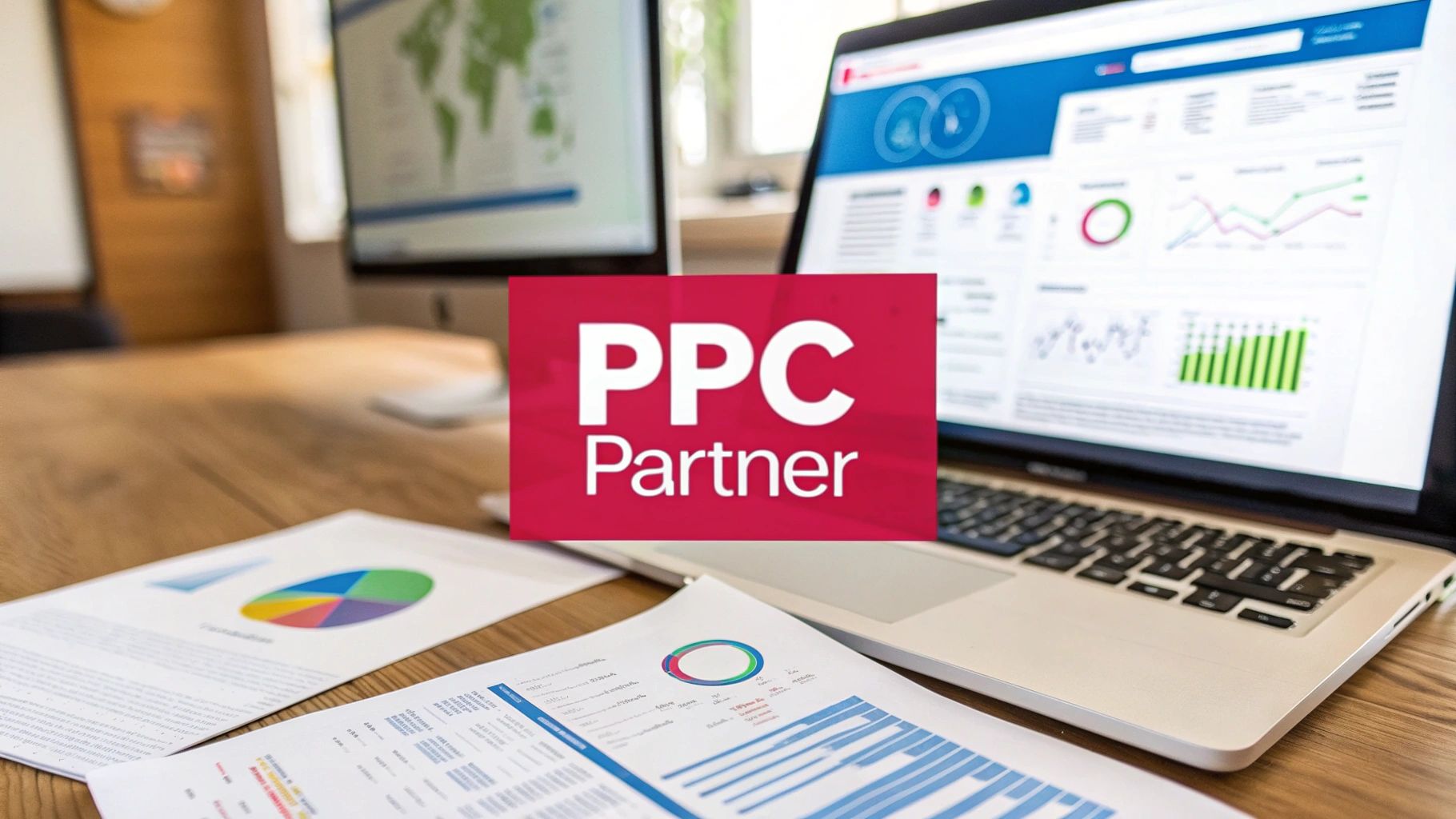Let's be honest: a real email marketing automation strategy isn't about setting up a few scheduled blasts and calling it a day. It’s about building intelligent, timely conversations that actually drive business forward. This is what separates you from the noise in a crowded inbox.
Building Your Foundational Automation Strategy
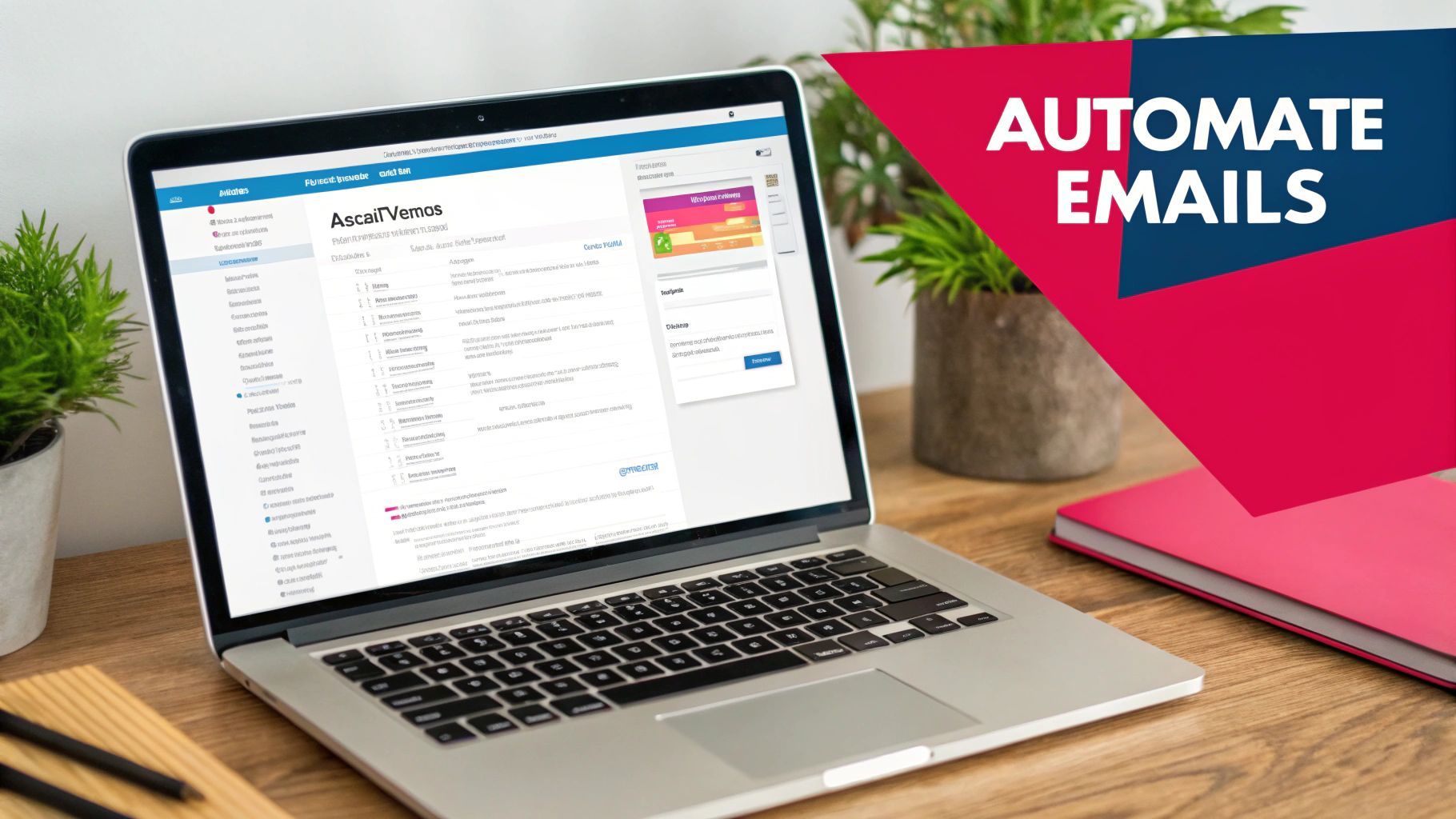
If you're still relying on generic, one-size-fits-all emails, you're already behind. A thoughtful automation strategy is the powerhouse of modern marketing, transforming simple touchpoints into data-driven interactions that feel personal. It gives you the power to reach the right person with the right message, right when it counts.
The whole point is to move away from the old "one-to-many" broadcast model. Instead, you're creating a "one-to-one" dialogue, but at scale. When done right, every automated email feels less like a sales pitch and more like a genuinely helpful follow-up from a real person.
Why This Strategic Shift Matters
This isn't just a nice-to-have; it's a significant revenue driver. The marketing automation market in the Middle East and Africa (MEA) alone hit USD 425.7 million in 2024. Email marketing was the biggest piece of that pie, making up 27.08% of the total.
These numbers prove that businesses investing in a proper automation strategy are doing more than just saving time—they're building a reliable revenue channel. The real goal is to create automated systems that feel anything but robotic.
A well-crafted automation strategy does more than save time. It builds trust by delivering value at every stage of the customer journey, from the first welcome email to a personalized offer six months later.
The Pillars of a Winning Strategy
To build an automation engine that truly delivers, you need a solid foundation. These pillars will guide every decision you make, from the software you pick to the emails you write. A great modern B2B email marketing strategy, for example, is built on a clear understanding of how each automated workflow supports the bigger picture.
Building a robust automation strategy rests on four essential pillars. Think of them as the load-bearing walls of your entire email marketing house—without them, things get wobbly fast. Each one has a distinct purpose, but they all work together to create a cohesive and effective system.
Key Pillars of an Automation Strategy
| Pillar | Primary Goal | Key Actions |
|---|---|---|
| Clear Objectives | Align automation with business goals. | Define KPIs like conversion rates, customer lifetime value, and lead quality. |
| Audience Segmentation | Deliver highly relevant content. | Group contacts by behavior, purchase history, demographics, and engagement. |
| Technology Selection | Choose tools that support your goals. | Evaluate platforms on integrations, scalability, and quality of analytics. |
| Journey Mapping | Understand and anticipate customer needs. | Visualize the customer path to identify key moments for automated messages. |
By grounding your efforts in these fundamentals, you’re not just sending emails; you're creating intentional workflows that engage your audience and directly impact your bottom line. It's how you ensure every automated message has a purpose.
Mapping Your Customer Journey for Smarter Automation
A truly effective email marketing automation strategy isn't built on code; it’s built on empathy. Before you even think about creating a workflow, you have to get inside your customer's head. What are they thinking, feeling, and struggling with as they interact with your brand? This is about more than a generic sales funnel—it's about creating a detailed, visual map of their entire experience.
The whole point is to find those critical moments where a perfectly timed, automated email can genuinely help. Forget abstract theories for a moment and focus on the practical path your customer takes from initial interest to final purchase.
This simple flow shows how your campaign goals should inform your audience segments, which then determine the right automation triggers.
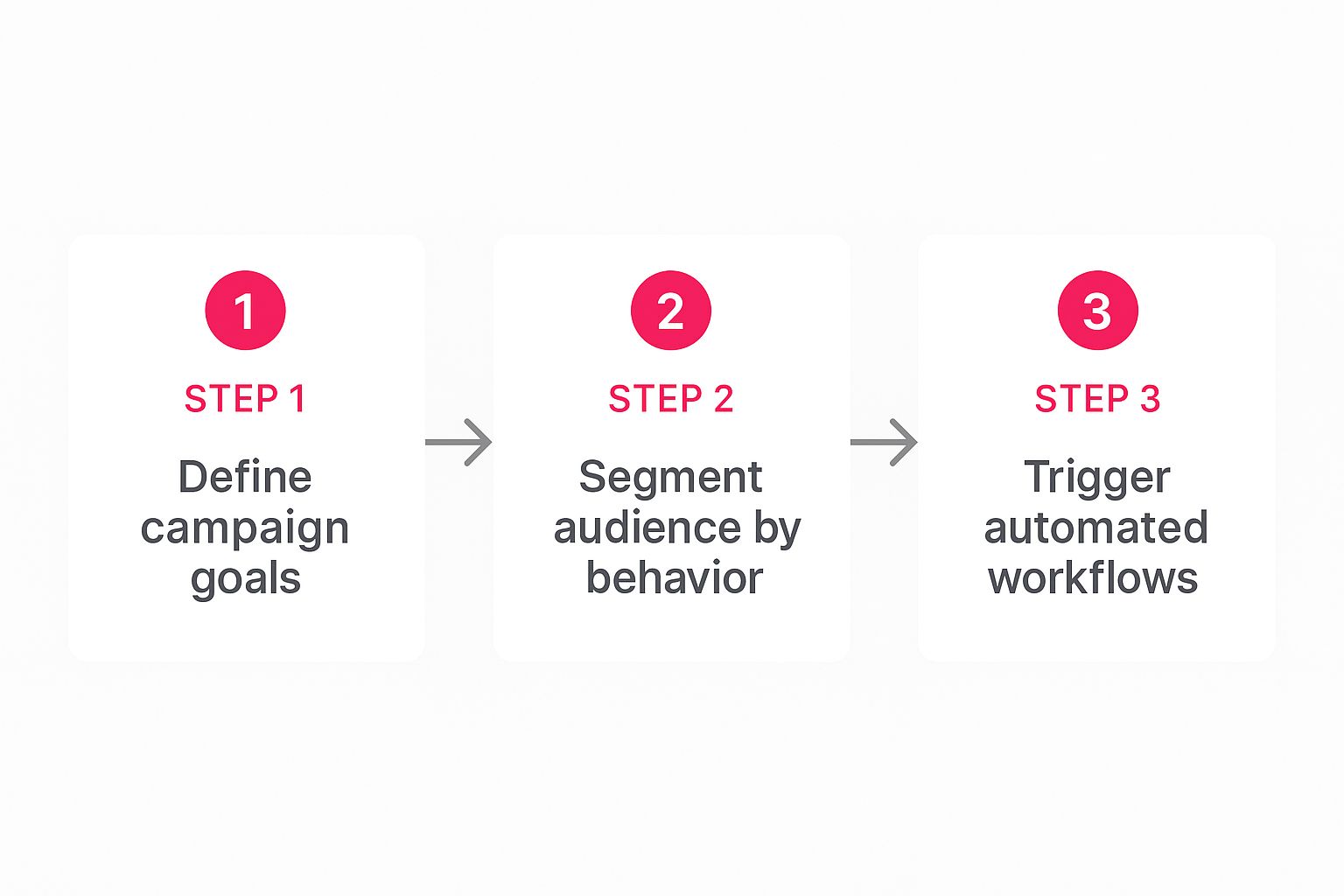
As you can see, great automation isn't just a series of random emails. It’s a thoughtful sequence where every step logically connects to the last, making your communication feel incredibly relevant.
Identifying Key Moments and Triggers
Your journey map should highlight the specific actions that reveal a customer’s intent. These are your triggers—the exact moments that tell your automation platform to jump into action. Don't guess what these are; look at your actual user data.
For an e-commerce store, a trigger might be:
- A shopper browses the same product category several times without adding anything to their cart.
- A customer puts a few high-value items in their cart, then leaves.
- Someone signs up for your newsletter through a pop-up promising a first-time discount.
For a SaaS company, the triggers would look a little different:
- A new trial user tries out a key, high-value feature for the first time.
- A user's trial is 7 days away from expiring, but they haven't taken a crucial next step.
- A customer downloads a detailed guide comparing your plans.
Each one of these moments is a golden opportunity. It’s your chance to send a message that, while automated, feels personal and helpful because it’s a direct response to something they just did.
From Blueprint to Automated Reality
Once you've identified these touchpoints, you can start designing the email sequences that match them. You're essentially creating a blueprint that connects a customer's action to your automated response. This visual plan makes sure every single email has a clear purpose.
A well-drawn customer journey map is the most important document in your automation toolkit. It transforms your strategy from a collection of isolated campaigns into a cohesive system that guides customers from one stage to the next.
This isn't just a technical task; it's a deeply strategic one. To build a map that works, you need to understand the subtle ways people interact with your business. For a really practical walkthrough, this guide on how to create a customer journey map is an excellent resource.
When you invest the time upfront to map this journey, you ensure your automation feels less like a machine and more like a helpful hand on the shoulder. It’s the foundation for sending emails that don't just get opened—they build real relationships and drive results.
Designing High-Impact Automation Workflows
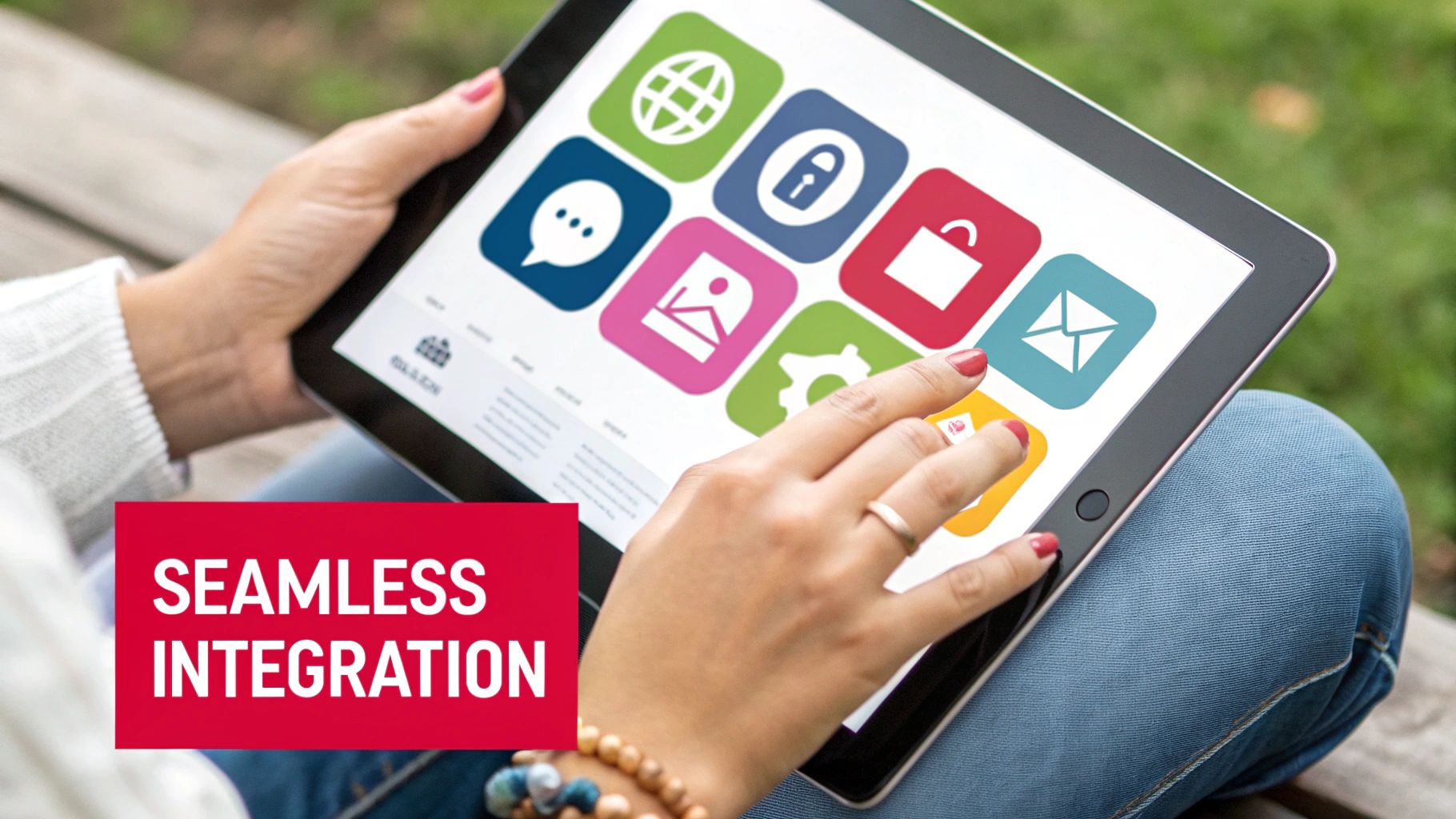
Alright, you've mapped out the customer journey. Now for the fun part: bringing that blueprint to life with an email marketing automation strategy. This is where we build the automated sequences that work for you around the clock to engage, nurture, and ultimately convert your audience.
The idea isn't to just blast out robotic messages. We're aiming to create intelligent, context-aware conversations. Each workflow you build should have one clear purpose, whether that's rolling out the red carpet for a new subscriber or winning back a potential sale.
The Essential Welcome Series
Your welcome series is your digital handshake. It’s your best shot at making a stellar first impression and setting the stage for everything that follows. Please, don't squander this moment with a single, boring "thanks for subscribing" email. A multi-step sequence is the way to go.
A truly effective welcome workflow needs to accomplish a few things right off the bat:
- Deliver the Goods: If they signed up for a discount code or a special guide, give it to them immediately in that first email. No delays.
- Set Expectations: Be upfront. Let them know what kind of emails you'll be sending and how often they can expect to hear from you.
- Show Off a Little: Use the next few emails to tell your brand's story, showcase your most-loved products, or share your absolute best content.
From my experience, the welcome series consistently gets the highest open and engagement rates of any automation. A thoughtfully crafted sequence here can give your long-term engagement and initial sales a serious boost.
Nurturing Leads from Interest to Action
Let's be real: most leads aren't ready to buy the second they land on your list. A lead nurture workflow is your tool for building trust and gently guiding prospects toward a buying decision on their own timeline. This is your chance to educate, solve problems, and establish yourself as the go-to expert.
The best nurture sequences feel less like a sales pitch and more like a helpful conversation. They proactively answer questions the prospect hasn't even thought of yet, building massive credibility with every single email.
Imagine someone downloads your guide on "how to choose the right software." Your follow-up sequence could then drip out emails that:
- Share a case study of a similar business that found success with your solution.
- Offer a no-pressure demo or a free consultation call.
- Address common frustrations that your software is built to eliminate.
This strategy keeps your brand top-of-mind, positioning you as the obvious choice when they're finally ready to pull the trigger.
Recovering Revenue with Abandoned Cart Workflows
For any e-commerce brand, an abandoned cart workflow isn't just a good idea—it's essential. A staggering 70% of online shopping carts are left behind before a purchase is made. An automated email sequence is your single most powerful tool for clawing back a huge chunk of that lost revenue.
A simple reminder email is a start, but a truly great abandoned cart sequence is more strategic. I've seen a three-part workflow work wonders:
- Email 1 (1-2 hours after abandonment): Send a gentle, helpful nudge. Something like, "Did you forget something?" often does the trick.
- Email 2 (24 hours later): Introduce a bit of social proof or urgency. Think "Your items are selling fast!" or "See what other customers are saying."
- Email 3 (48-72 hours later): If they're still on the fence, offer a small incentive. A modest discount or free shipping can be the final push they need.
The power of these tools is undeniable. In fact, the MEA marketing automation software market is valued at around USD 380 million in 2024 and is projected to explode to nearly USD 1 billion by 2033. This growth highlights just how critical these automations have become.
Using Behavioral Data for Deeper Personalization
The real magic of an email marketing automation strategy happens when you go beyond basic triggers. Using behavioral data—what people actually do on your website—lets you create incredibly relevant experiences. This means you're segmenting people not just by the list they joined, but by their actions.
This level of personalization requires some sophisticated segmentation. To get a better handle on this, you can learn more about 7 advanced email marketing segmentation examples and see how to put these ideas into practice. When you build workflows around actual user behavior, every email feels less like a marketing blast and more like a personal, one-to-one conversation.
Choosing Your Email Automation Technology Wisely
Picking the right technology is easily one of the most critical decisions you'll make for your entire email marketing program. Think of this platform as the engine for your strategy. Getting it right means looking past the shiny, headline features and digging into what will actually move the needle for your business.
What works for a small startup just won’t cut it for a large enterprise, and vice-versa. The goal here isn't to find the platform with the longest feature list. It's to find the one that meets you where you are today and has the headroom to grow with you tomorrow.
Beyond the Basics: What to Really Look For
Before you even think about signing a contract, you need to evaluate potential platforms on a few non-negotiable criteria. These are the elements that truly separate a decent tool from a great one.
- Powerful Integrations: How cleanly does the platform play with the rest of your tech? We're talking about your CRM, e-commerce store, analytics tools, and more. Data needs to flow seamlessly between systems for automation to really work its magic.
- Scalability: Will this platform choke when your contact list doubles? Or when you want to send a million emails in a month? You have to plan for success, otherwise, you'll face a painful and expensive migration down the road.
- Advanced Segmentation: This is where the money is made. You need the ability to slice and dice your audience based on their behavior, purchase history, and engagement levels. This is the key to sending hyper-relevant messages. For some inspiration on how this works in practice, you can explore these marketing automation workflow examples.
This decision is especially timely, with the Middle East marketing technology market expected to surge past USD 8 billion in 2024. Projections show a 20.2% CAGR through 2033, and email automation is a huge piece of that pie. Making the right platform choice now sets you up to ride that wave of growth. You can dive deeper into the regional market growth on cognitivemarketresearch.com.
Choosing your automation platform isn't just a technical decision; it's a strategic one. The right tool empowers you to execute your strategy flawlessly, while the wrong one creates constant friction and limits your potential.
A Quick Comparison for Different Business Sizes
To put this into perspective, let's look at how feature priorities can change based on your company's scale.
Automation Platform Feature Comparison
| Feature | Small Business Focus | Mid-Market Focus | Enterprise Focus |
|---|---|---|---|
| User Interface | Intuitive, easy to learn, drag-and-drop builder. | Customizable dashboards, user roles & permissions. | Full customization, API access for custom UIs. |
| Integrations | Key native integrations (Shopify, WordPress, etc.). | Robust API, extensive app marketplace. | Custom integration support, dedicated API teams. |
| Segmentation | Basic tagging and list-based segmentation. | Dynamic segmentation based on web behavior, lead scoring. | Predictive analytics, multi-channel behavior tracking. |
| Reporting | Core email metrics (opens, clicks, unsubscribes). | Advanced campaign reporting, A/B testing analysis. | Full funnel attribution, custom BI tool connectors. |
| Support | Email/chat support, extensive knowledge base. | Dedicated account manager, phone support. | Premier support, SLAs, technical consulting. |
This table illustrates that while everyone needs the same core features, the depth and complexity required evolve significantly as a business grows.
Making a Confident Decision
So, how do you make the final call? Start by getting crystal clear on your budget and your absolute, must-have features. A startup might prioritize a user-friendly interface and a low-cost entry point from a platform like MailerLite. In contrast, a larger business might need the robust analytics and multi-channel muscle of a tool like HubSpot.
Draw up a shortlist of two or three serious contenders. Get demos from all of them. Ask tough questions. Ultimately, you're not just buying software; you're choosing a partner that will be central to your long-term growth.
How to Measure and Refine Your Automation Engine
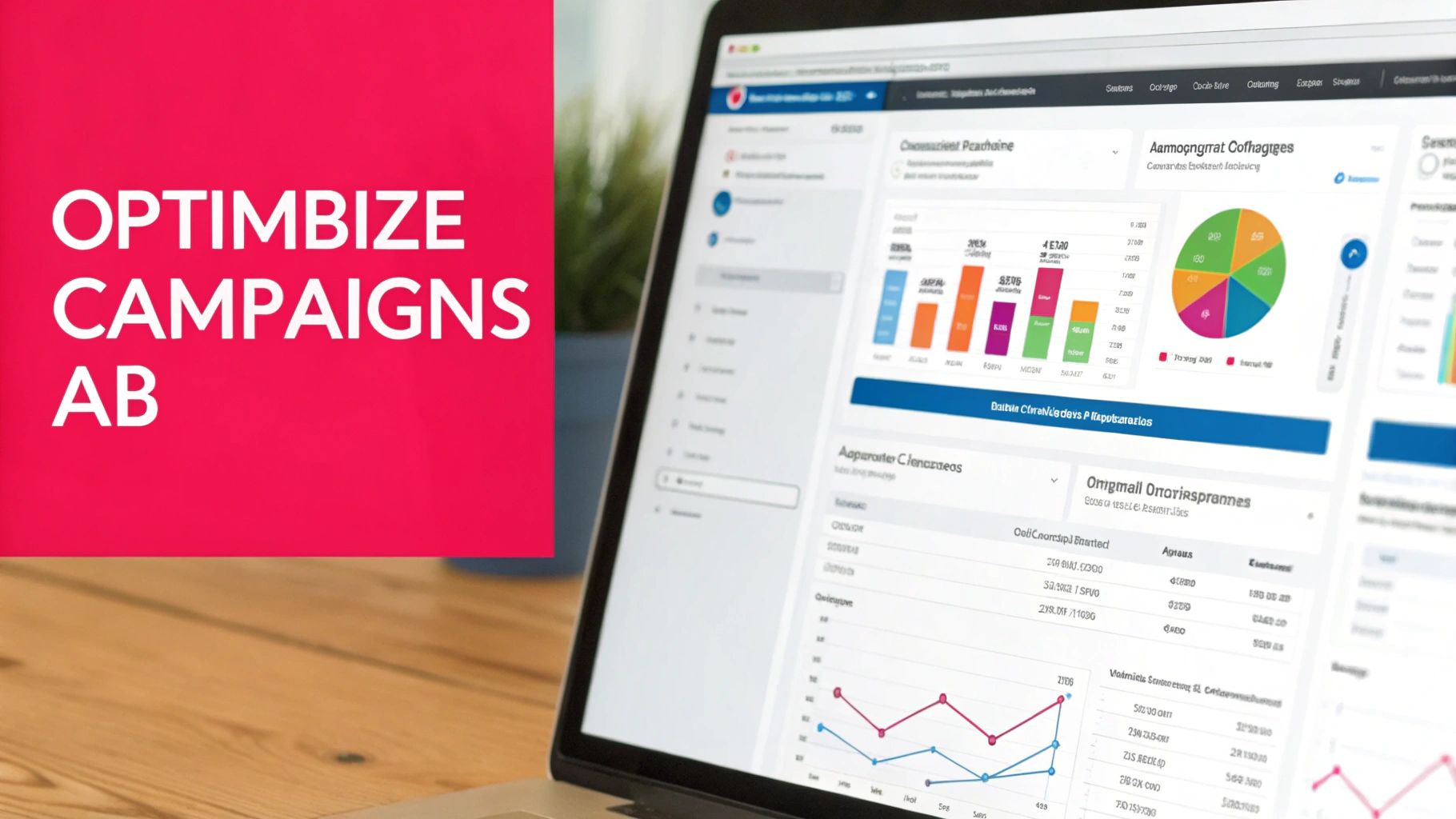
Getting your first automated workflows live is a fantastic milestone. But don't pop the champagne just yet—this is where the real work begins. The most powerful automation strategies aren't "set it and forget it." They are living, breathing systems that you constantly monitor, test, and tweak.
Think of it like tuning a high-performance engine. Your job is to keep listening for opportunities to make it run smoother, faster, and more efficiently. This commitment to continuous improvement is what will ultimately separate a decent automation setup from a truly great one.
Look Beyond Vanity Metrics
It's tempting to obsess over open rates and click-through rates. They're right there on your dashboard, after all. But while they give you a quick pulse check, they don't paint the full picture. A sky-high open rate means nothing if those subscribers aren't taking the actions that actually move your business forward.
To get a real sense of your automation's impact, you have to dig deeper into performance-driven Key Performance Indicators (KPIs). These are the numbers that connect your email activity directly to revenue and meaningful customer behavior. To get started, you should familiarize yourself with the most essential email marketing KPIs and how they're measured.
I always tell my clients to focus on these three:
- Workflow Conversion Rate: Of all the people who enter a specific flow—like a welcome series or an abandoned cart sequence—what percentage actually completes the goal? That could be making a purchase, signing up for a webinar, or booking a call.
- Revenue Per Email (RPE): This is a game-changer. It tells you exactly how much money, on average, each email in a sequence is generating. This is how you find your workhorse emails and identify the weak links.
- Impact on Customer Lifetime Value (CLV): Do customers who receive your nurture sequences stick around longer and spend more over time? Tracking this reveals the long-term, relationship-building power of your automation.
The real story of your automation success isn't told by how many people opened your email. It's told by how many of them took the action you wanted them to take because of that email.
The Power of Systematic A/B Testing
Once you know which metrics you need to move, you can start improving them with A/B testing. This isn't about throwing spaghetti at the wall to see what sticks; it’s a disciplined, scientific approach to optimizing every piece of your automated emails.
The key is to avoid testing too many things at once. You need to isolate a single variable to get clean, reliable data. For instance, let’s say you're working on your abandoned cart workflow. You could set up tests for:
- Subject Lines: Pit a direct, urgent subject like "You left something behind" against a benefit-focused one like "Your items are waiting… and going fast!"
- Call-to-Action (CTA): Test a button that says "Return to Your Cart" against one that says "Complete Your Purchase." The difference in language can have a surprising impact.
- Email Timing: Does sending the first reminder after 1 hour perform better than waiting 4 hours? Only a test will tell you for sure.
- Incentives: In the final email of the series, does including a 10% discount code convert better than offering free shipping?
By testing one thing at a time, you can confidently say that any change in performance was due to that specific tweak. Make sure to document everything you learn. Over time, these small, data-backed wins add up, creating a much stronger email marketing automation strategy and a healthier bottom line. You're building a playbook of what truly resonates with your unique audience.
Got Questions About Email Automation? Let's Clear Things Up.
Jumping into email automation for the first time? It's natural to have a few questions pop up. Honestly, getting these sorted out early on is one of a key to building workflows that actually work instead of just running in the background.
Let's tackle some of the most common things I hear from people just getting started.
"How much personalization is too much?"
This is a big one. Nobody wants to come off as creepy, but generic emails don't get results. Where's the line?
Think of it this way: use data that adds genuine value for the customer. Calling them by their first name is table stakes. But pointing out they viewed a specific product 3 times yesterday? That’s not creepy; it's helpful. It allows you to send a timely follow-up with a special offer or more information on that exact item. The goal is to be relevant and helpful, not just to show you have their data.
"When should a real person step in?"
Automation is a massive time-saver, but it’s not a replacement for genuine human connection. The smartest strategies I've seen always have built-in triggers for when a person should take over.
Imagine a potential customer visits your pricing page, then comes back a day later to look again. Instead of letting another automated email fly, that’s a perfect signal to have a sales team member send a personal note. This combination of automation for efficiency and a human touch for high-intent moments is what really sets a great experience apart.
The best automation strategies aren't "set it and forget it." They're designed to flag high-value opportunities so a real person can step in and close the deal. It’s about blending efficiency with intuition.
"Is my email list big enough to even bother with automation?"
I hear this concern all the time, especially from small businesses. The answer is a resounding yes. The size of your list is far less important than how you treat the people on it.
Even if you only have 100 subscribers, setting up a simple welcome series can completely change how new leads feel about your brand. It immediately establishes you as professional and organized. Plus, those first subscribers are often your biggest fans and future evangelists. Nurturing them from day one is one of the smartest investments you can make. It builds a solid foundation that will support your growth for years to come.
Ready to build an email marketing automation strategy that drives real results? Grassroots Creative Agency specializes in creating data-supported campaigns that convert. We combine bold creative with precise analytics to grow your brand. Learn how we can elevate your digital marketing today.

